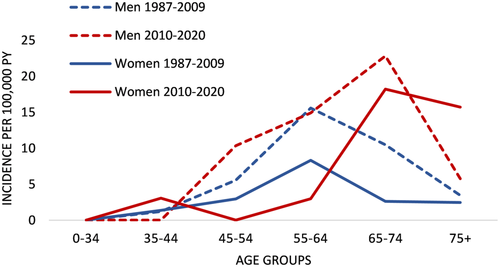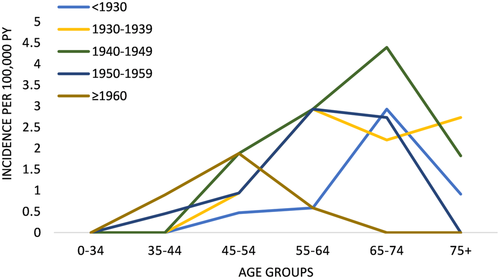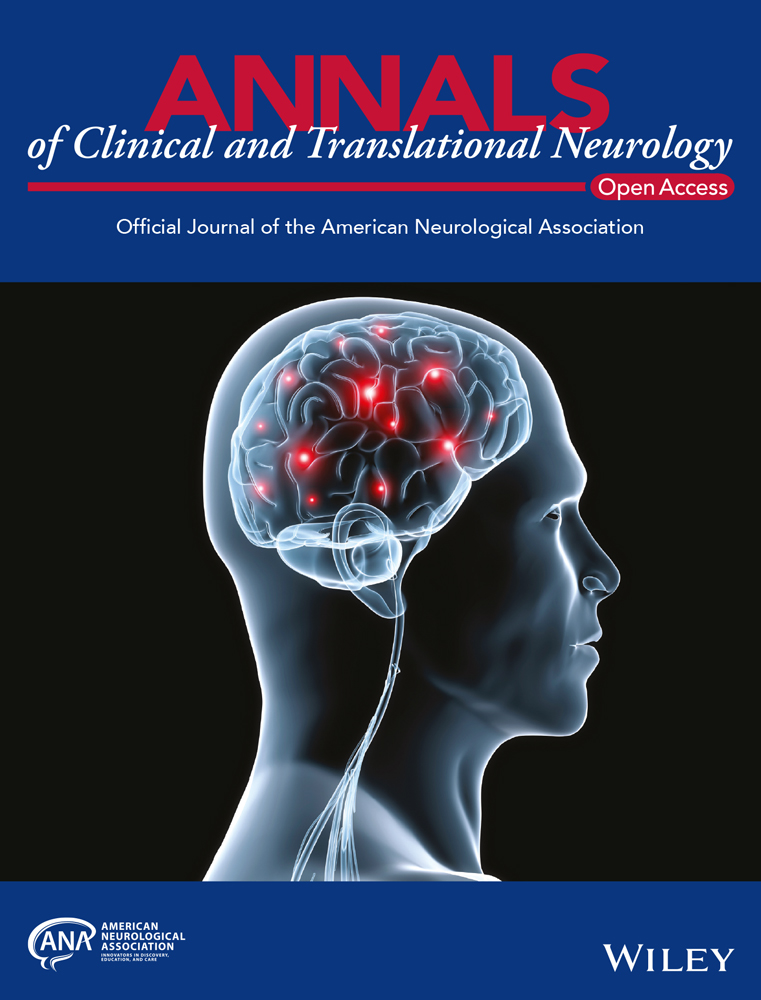High incidence of amyotrophic lateral sclerosis in the Faroe Islands 2010–2020
Funding Information:
This study was funded by the Aage and Johanne Louis-Hansen Fond, The Faroese Health Assurance Fund, Minister Erna Hamiltons Legat for Videnskab og Kunst, and Betri Stuðulsgrunnurin.
Abstract
The Faroese population isolate harbors epidemiological and genetic characteristics that likely differ from outbred populations. This population-based register study found that the Faroese 2010–2020 crude incidence of amyotrophic lateral sclerosis (ALS) was 4.9/100,000 person-years (95% confidence interval [CI], 3.3–7.0) and the age- and sex-standardized incidence (US 2010 Census Population) was 4.1/100,000 person-years (95% CI, 2.7–6.0), which is a 68% increase from the 1987–2009 estimate. The 2020 crude prevalence was 9.5/100,000 (95% CI, 3.0–19.6) in a population of 52,912 inhabitants. Incidence and prevalence estimates of ALS in the Faroes are high and further research is warranted to uncover the genetic or environmental determinants of ALS in this population.
Introduction
Amyotrophic lateral sclerosis (ALS) is a fatal neurodegenerative disease characterized by rapidly progressive muscle weakness and atrophy caused by the loss of motor neurons in the cortex, brain stem, and spinal cord.1 Median age at onset is 65 years, survival being roughly 3–4 years from disease onset.1 Worldwide ALS incidence is heterogeneous ranging between 0.6 and 3.8/100,000 person-years (py). In Europe, incidence shows smaller variation ranging from 2.1 to 3.8/100,000 py. It is likely that the observed variation correlates with genetic ancestry and differences in exposure to environmental risk.2, 3 Some studies indicate that the incidence of ALS may have increased over the last three decades,4-6 which may be attributed to changing population structures with increased longevity and improved case ascertainment but changing environmental factors may also contribute.7 In the Faroe Islands, the crude incidence of ALS was 2.6/100,000 py during 1987–2009 and the prevalence was 8.2/100,000 py on 31 December 2009.8 Here we report an up-to-date estimate of the ALS incidence and prevalence in the Faroes for the period 1 January 2010–31 December 2020.
Methods
We conducted a population-based study to determine the incidence and prevalence of ALS in the Faroe Islands between 1 January 2010 and 31 December 2020. Located in the North Atlantic, the Faroe Islands is an archipelago consisting of 18 small islands. The population is of Nordic and Celtic origin9 and in many aspects comparable to other Western populations. The demographics of the Faroes Islands have been quite stable for decades and life expectancy is one of the highest in the world being 85.8 years for women and 80.6 for men.10 The Faroes have a Scandinavian type high-quality health-care system financed by general taxes and statutory health insurance securing universal, free, and equal health care for all citizens. Patients with suspected neuromuscular disease are referred to the Medical Department at the National Hospital by their general practitioners and undergo diagnostic work-up by consultant neurologists there and/or at Bispebjerg Hospital or Rigshospitalet in Copenhagen, Denmark (n = 17). Patients with ALS diagnoses retrieved from the Diagnoses Registry at the National Hospital were included after verifying the ALS diagnosis according to the revised El Escorial diagnostic criteria,11 excluding patients with progressive muscular atrophy or primary lateral sclerosis. Disease onset was defined as self-reported month/year of symptoms of reduced muscle power. Additionally, onset was classified into bulbar, spinal, or generalized type onset. Survival time was calculated from the date of onset to the date of death. The study was approved by the Faroese Ethics Committee and the Faroese Data Protection Agency.
Statistical analysis
A crude incidence rate was calculated for the period 1 January 2010–31 December 2020 using the person-year method. The denominator for the calculation was the mean Faroese population for the 2010–2020 period (mid-month estimates). Crude age-specific incidence rates were calculated for 10-year age groups between 35 and <75 years (0–34, 35–44, 45–64, 65–74, and 75+ years), comparable to previous Faroese estimates.8 Crude age-specific incidence rates by birth cohort were used to provide additional information on cohort-specific incidences. Incidence rates were age and sex standardized to the US 2010 Census Population12 by direct-standardization. Both the 2010–2020 and 1987–2009 incidence rates were age standardized to the US 2010 Census Population to allow comparisons of adjusted incidences across age groups. Those alive on 31 December 2020 were included in the prevalence estimate using end-month population as denominator. The 95% confidence intervals (CI) were calculated assuming a Poisson distribution.
Results
Twenty-seven patients were diagnosed with ALS between 1 January 2010 and 31 December 2020. The median age at onset was 67 years (range, 44–80) and mean survival was 2.3 years (Table 1). The 2010–2020 crude incidence of ALS was 4.9/100,000 py (95% CI, 3.3–7.0) and higher among men with a male-to-female incidence ratio of 1.5:1. Sex-stratified analyses showed that the male specific incidence was 5.7/100,000 py (95% CI, 3.6–9.0) compared to 3.9/100,000 py (95% CI, 2.1–6.8) among females, and highest in the 65–74 age group. The age- and sex-standardized incidence was 4.1/100,000 py (95% CI, 2.7–6.0) and higher compared with the 1987–2009 estimate3 (Table 1). The largest increase in age-standardized incidence rate from 1987–2009 to 2010–2020 was observed in age groups 65–74 and 75+ (Fig. 1). The increase was especially dominated by women (Fig. 2), with the highest incidence observed in the 1940–1949 birth cohort (Fig. 2). A tendency for earlier onset was also observed in younger cohorts (Fig. 3). There were five prevalent patients on 31 December 2020 corresponding to a crude prevalence of 9.5/100,000 (95% CI, 3.0–19.6) in a population of 52,912. Collectively, 55 patients have been diagnosed with ALS during 1987–2020. The overall crude incidence for the 1987–2020 period was 3.3/100,000 py (95% CI, 2.5–4.3) and the age-standardized incidence was 3.4/100,000 py (95% CI, 2.6–4.5).
| Characteristics | Period 2010–2020 | Period 1987–20091 | Overall 1987–2020 |
|---|---|---|---|
| No. cases | 27 | 28 | 55 |
| Age at onset, median y (range) | 67 (44–80) | 57 (42–86) | |
| Gender ratio (male:female) | 1.5:1 | 2.1:1 | 1.8:1 |
| Survival time, mean y (range) | 2.3 (0.2–6.1) | 2.8 (1–12) | |
| Site of onset, No. cases (%) | |||
| Spinal | 7 (26) | 17 (61) | 24 (44) |
| Bulbar | 16 (59) | 11 (39) | 25 (46) |
| Generalized | 2 (7) | – | 3 (6) |
| Unknown | 2 (7) | – | 3 (6) |
| Crude incidence/100,000 py, (CI) | 4.9 (3.3–7.0) | 2.6 (1.7–3.7) | 3.3 (2.5–4.3) |
| Incidence in age groups, incidence (no of cases) | |||
| 0–34 | 0.0 (0) | 0.0 (0) | |
| 35–44 | 1.4 (1) | 1.3 (2) | |
| 45–54 | 5.4 (4) | 4.3 (6) | |
| 55–64 | 9.2 (6) | 12.3 (13) | |
| 65–74 | 18.2 (11) | 6.5 (5) | |
| 75+ | 12.5 (6) | 2.9 (2) | |
| Age, gender standardized12 incidence/100,000 py, (CI) | 4.1 (2.7–6.0) | 2.9 (1.8–4.0) | |
| Age standardized12 incidence/100,000 py, (CI) | 4.3 (2.7–6.7) | 2.9 (2.0–4.5) | 3.4 (2.6–4.5) |
- py, person-years; ALS, amyotrophic lateral sclerosis; CI, confidence interval.
- 1 Data from Joensen (2012).8



Discussion
Here, we report an up-to-date estimate of the ALS incidence in the Faroe Islands. We found a crude incidence of 4.9/100,000 py for the 2010–2020 period which is higher than the previous Faroese estimate of 2.6/100,000 py,8 and to our knowledge the highest reported in literature. High incidences of motor neuron disease (MND) have been reported recently within the Swedish and Scottish populations (3.8/100,000 py).3, 6, 13 Results however are not directly comparable as our estimate reflect the incidence of ALS and is expected to underestimate the incidence of MND in general by 10%.1 Several factors may cause the observed increased incidence. Life expectancy of the Faroese population is one of the highest in the world having increased steadily over the last decades. From 2009 to 2020, life expectancy in the Faroes increased from 78.2 to 80.6 in men and 83.3 to 85.8 in women.10 Advanced age increases years at risk of developing ALS and could explain the increased incidence of ALS.7 The influence of age and sex on the Faroese 2010–2020 incidence rate, as compared to the US population, was confirmed by standardization, which decreased the rate to 4.1/100,000. Still, this was a high incidence estimate compared to other European rates. Similarly, standardizing the incidence to the 1987–2009 Faroese age structure, the 2010–2020 estimate was still 68% higher. Thus, the increased incidence observed is not likely caused by changes in age structure of the Faroese society. The increase was largely attributable to an increased number of cases in the age groups 65–74 and +75, especially among females born during 1940–1949, which is in accordance with other studies suggesting that the male/female ratio has decreased over the last decades, driven especially by increased incidence of ALS in older women.7, 14 Greater willingness to seek medical help and changing lifestyles which expose women to similar environmental risk factors as men are suggested explanations for this observation.7 Though we should be careful when interpreting on small sample sizes, age-cohort analyses did also suggest that ascertainment among younger individuals has improved in later cohorts. Thus, improved ascertainment especially in older women and younger individuals may contribute to increased incidence rates observed in the Faroes. A major strength of this study is the nationwide nature including all diagnosed cases in the Faroe Islands and the long study period. Thus, albeit sample size constitutes a limitation, we believe this incidence estimate to be robust. Many studies have shown that marked differences exist between ethnic groups and geographical regions with respect to genes implicated with ALS.15 The high incidence of ALS in the Faroese population could thus reflect population-specific environmental exposures or genetic factors such as a founder effect.16 We have previously reported on a geographical cluster of ALS in the Faroe Islands, where the occurrence of the disease was three times higher on the isolated island of Suðuroy compared to the rest of the islands. On the same note, the rate of familial ALS in the Faroe Islands is, depending on defining criteria,17 between 14 and 28%,18 which is relatively high. A next step would be to look into the genetic risk factors of ALS in the Faroes. Several environmental risk factors are proposed to associate with ALS, hereunder environmental pollutants.19, 20 Traditional Faroese diet is rich in seafood including whale meat and blubber which is likely contaminated with persistent pollutants such as methylmercury and polychlorinated biphenyls (PCBs).21 Fetal mercury exposure has already been shown to have negative impact on Faroese children’s neurobehavioral development.22 Moreover, the prevalence of Parkinson’s disease, another neurodegenerative disease, is twice as high in the Faroes compared to neighboring countries, with risk being significantly associated with increased dietary intake of whale meat and blubber.23 Thus, high intake of mercury- and PCB-contaminated seafood could be a risk factor of ALS in the Faroe Islands and needs further investigation. In summary, the crude and adjusted incidence of ALS in the Faroe Islands is, to our knowledge, the highest reported, having increased 68% since last estimated in 1987–2009. The increase was highest among women above 65 years. We have previously reported high rates of familial ALS and geographic clustering in the Faroes Islands. An important next step will be to look into the genetic determinants of ALS in the Faroes.
Acknowledgments
This study was funded by the Aage and Johanne Louis-Hansen Fund, The Faroese Health Assurance Fund, Minister Erna Hamiltons Legat for Videnskab og Kunst, and Betri Stuðulsgrunnurin.
Author Contributions
M. J. and M. S. P. contributed to the conception and design of study. M. J., M. S. P., B. A. S., G. A., K. S., T. H., and P. J. contributed to the acquisition and analysis of data. M. J. and M. S. P. contributed to drafting the text. M. J. contributed to drafting the figures.
Conflict of Interest
Nothing to report.




